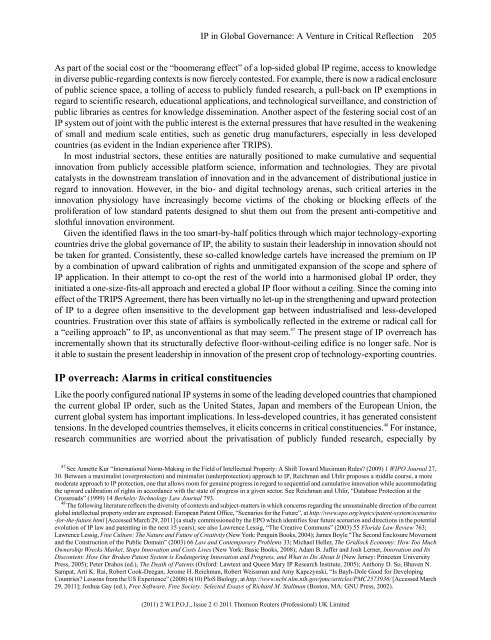WIPO Journal - World Intellectual Property Organization
WIPO Journal - World Intellectual Property Organization
WIPO Journal - World Intellectual Property Organization
You also want an ePaper? Increase the reach of your titles
YUMPU automatically turns print PDFs into web optimized ePapers that Google loves.
As part of the social cost or the “boomerang effect” of a lop-sided global IP regime, access to knowledge<br />
in diverse public-regarding contexts is now fiercely contested. For example, there is now a radical enclosure<br />
of public science space, a tolling of access to publicly funded research, a pull-back on IP exemptions in<br />
regard to scientific research, educational applications, and technological surveillance, and constriction of<br />
public libraries as centres for knowledge dissemination. Another aspect of the festering social cost of an<br />
IP system out of joint with the public interest is the external pressures that have resulted in the weakening<br />
of small and medium scale entities, such as genetic drug manufacturers, especially in less developed<br />
countries (as evident in the Indian experience after TRIPS).<br />
In most industrial sectors, these entities are naturally positioned to make cumulative and sequential<br />
innovation from publicly accessible platform science, information and technologies. They are pivotal<br />
catalysts in the downstream translation of innovation and in the advancement of distributional justice in<br />
regard to innovation. However, in the bio- and digital technology arenas, such critical arteries in the<br />
innovation physiology have increasingly become victims of the choking or blocking effects of the<br />
proliferation of low standard patents designed to shut them out from the present anti-competitive and<br />
slothful innovation environment.<br />
Given the identified flaws in the too smart-by-half politics through which major technology-exporting<br />
countries drive the global governance of IP, the ability to sustain their leadership in innovation should not<br />
be taken for granted. Consistently, these so-called knowledge cartels have increased the premium on IP<br />
by a combination of upward calibration of rights and unmitigated expansion of the scope and sphere of<br />
IP application. In their attempt to co-opt the rest of the world into a harmonised global IP order, they<br />
initiated a one-size-fits-all approach and erected a global IP floor without a ceiling. Since the coming into<br />
effect of the TRIPS Agreement, there has been virtually no let-up in the strengthening and upward protection<br />
of IP to a degree often insensitive to the development gap between industrialised and less-developed<br />
countries. Frustration over this state of affairs is symbolically reflected in the extreme or radical call for<br />
a “ceiling approach” to IP, as unconventional as that may seem. 47 The present stage of IP overreach has<br />
incrementally shown that its structurally defective floor-without-ceiling edifice is no longer safe. Nor is<br />
it able to sustain the present leadership in innovation of the present crop of technology-exporting countries.<br />
IP overreach: Alarms in critical constituencies<br />
IP in Global Governance: A Venture in Critical Reflection 205<br />
Like the poorly configured national IP systems in some of the leading developed countries that championed<br />
the current global IP order, such as the United States, Japan and members of the European Union, the<br />
current global system has important implications. In less-developed countries, it has generated consistent<br />
tensions. In the developed countries themselves, it elicits concerns in critical constituencies. 48 For instance,<br />
research communities are worried about the privatisation of publicly funded research, especially by<br />
47 See Annette Kur “International Norm-Making in the Field of <strong>Intellectual</strong> <strong>Property</strong>: A Shift Toward Maximum Rules? (2009) 1 <strong>WIPO</strong> <strong>Journal</strong> 27,<br />
30. Between a maximalist (overprotection) and minimalist (underprotection) approach to IP, Reichman and Uhlir proposes a middle course, a more<br />
moderate approach to IP protection, one that allows room for genuine progress in regard to sequential and cumulative innovation while accommodating<br />
the upward calibration of rights in accordance with the state of progress in a given sector. See Reichman and Uhlir, “Database Protection at the<br />
Crossroads” (1999) 14 Berkeley Technology Law <strong>Journal</strong> 793.<br />
48 The following literature reflects the diversity of contexts and subject-matters in which concerns regarding the unsustainable direction of the current<br />
global intellectual property order are expressed: European Patent Office, “Scenarios for the Future”, at http://www.epo.org/topics/patent-system/scenarios<br />
-for-the-future.html [Accessed March 29, 2011] (a study commissioned by the EPO which identifies four future scenarios and directions in the potential<br />
evolution of IP law and patenting in the next 15 years); see also Lawrence Lessig, “The Creative Commons” (2003) 55 Florida Law Review 763;<br />
Lawrence Lessig, Free Culture: The Nature and Future of Creativity (New York: Penguin Books, 2004); James Boyle “The Second Enclosure Movement<br />
and the Construction of the Public Domain” (2003) 66 Law and Contemporary Problems 33; Michael Heller, The Gridlock Economy: How Too Much<br />
Ownership Wrecks Market, Stops Innovation and Costs Lives (New York: Basic Books, 2008); Adam B. Jaffer and Josh Lerner, Innovation and Its<br />
Discontent: How Our Broken Patent System is Endangering Innovation and Progress, and What to Do About It (New Jersey: Princeton University<br />
Press, 2005); Peter Drahos (ed.), The Death of Patents (Oxford: Lawtext and Queen Mary IP Research Institute, 2005); Anthony D. So, Bhaven N.<br />
Sampat, Arti K. Rai, Robert Cook-Deegan, Jerome H. Reichman, Robert Weissman and Amy Kapczynski, “Is Bayh-Dole Good for Developing<br />
Countries? Lessons from the US Experience” (2008) 6(10) PloS Biology, at http://www.ncbi.nlm.nih.gov/pmc/articles/PMC2573936/ [Accessed March<br />
29, 2011]; Joshua Gay (ed.), Free Software, Free Society: Selected Essays of Richard M. Stallman (Boston, MA: GNU Press, 2002).<br />
(2011) 2 W.I.P.O.J., Issue 2 © 2011 Thomson Reuters (Professional) UK Limited

















